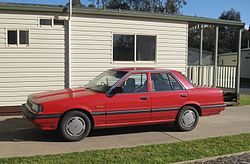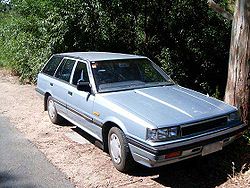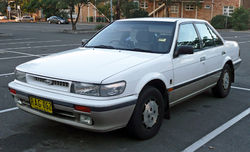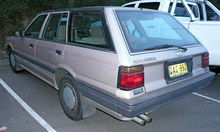- Nissan Pintara
-
Nissan Pintara 
Manufacturer Nissan Production 1986–1993 Assembly Clayton, Victoria, Australia Class Mid-size The Nissan Pintara is a mid-sized automobile that was manufactured by Nissan Australia from 1986 until 1992.
First generation (R31; 1986–1990)
R31 
Production 1986–1990 Body style 4-door sedan
5-door station wagonLayout FR layout Engine 2.0 L (1,974 cc) CA20E I4 The first generation R31 Nissan Pintara is a mid-sized family car which was built by Nissan Australia at its Clayton, Victoria assembly plant in Melbourne from mid 1986. Replacing the locally produced Nissan Bluebird (910), it was based on the Nissan Skyline [1] with a single fuel-injected 2.0 litre four-cylinder engine, entirely built and sold in Australia to compete with the Mitsubishi Magna. Like the Australian built six cylinder R31 Skyline, it was offered in sedan and station wagon form.
Four specification levels of the R31 Pintara were offered: GLi, Executive, GX, and GXE. A TRX bodykit package was offered for the GX and GXE sedans, featuring a front and rear air dam, rear spoiler, side skirts, grille cover, alloy wheels and low profile tyres. Unlike the later U12 TRX, it did not feature any mechanical upgrades.
The sole engine choice was a 2.0 litre CA20E inline-four, producing 78 kilowatts (105 hp) (DIN) at 5,200 rpm and 160 newton metres (120 ft·lbf) (DIN) at 3,200 rpm. This unit was SOHC, multi-point fuel injected featuring electronic concentrated control system (ECCS) including electronic ignition. It featured two spark plugs per cylinder to help meet emission requirements.
Second generation (U12; 1989–1992)
U12 
Also called Nissan Bluebird - unrelated to Nissan Bluebird elsewhere. (Japan, New Zealand)
Ford CorsairProduction 1989–1992 Body style 4-door sedan
5-door SuperhatchLayout FF layout Engine 2.0 L CA20E I4
2.4 L KA24E I4The first generation Pintara was replaced in 1989 by a model initially dubbed by the media as "Project Matilda", which turned out to be a locally produced front-wheel drive version of the Nissan Bluebird (U12), rather than a model uniquely designed for Australia as initial stories had indicated. In Australia, this was sold as the Nissan Pintara (U12), also available as a locally designed five-door "Superhatch". The Superhatch was exported to both Japan and New Zealand as the Nissan Bluebird. The U12 model was discontinued in mid-1992 when Nissan Australia ceased local production.
Under the Button car plan, in which local manufacturers shared models, Ford Australia marketed a rebadged version of the U12 Pintara sedan and hatchback as the Ford Corsair.
Nissan fitted a 2.0 litre CA20E inline-four engine to the GLi and Executive levels of trim. This engine was rated at 83 kilowatts (111 hp) (DIN) at 5,200 rpm for power, and 168 newton metres (124 ft·lbf) (DIN) at 4,000 rpm torque. [2]
T, Ti, and TRX versions received a 2.4 litre KA24E inline-four. This engine produced 96 kilowatts (129 hp) (DIN) at 5,600 rpm and 189 newton metres (139 ft·lbf) (DIN) at 2,800 rpm. [3] Fitted with electronic concentrated control system (ECCS) for precise MPI fuel injection, the 2.4 litre also featured ignition timing control with SOHC and three valves per cylinder (two intake, one exhaust).
References
- ^ Angas MacKenzie, Second Guessing Nissan Pintara, Car Australia, July 1986, pages 48-52
- ^ Ford Corsair sales brochure, Ford Motor Company of Australia Limited, September 1989
- ^ Ford Corsair sales brochure, Ford Motor Company of Australia Limited, September 1989
Nissan Motor Company Vehicles Current370Z • Advan • Altima • Aprio • Armada • Atlas • Bluebird • Bluebird Sylphy • Cabstar • Caravan • Civilian • Clipper • Cube • Dualis • Elgrand • Frontier • Freeson • Fuga • GT-R • Juke • Lafesta • Leaf • Livina Geniss • Maxima • March • Murano • Moco • Navara • Note • NV200 • NV400 • Otti • Paladin • Pathfinder • Patrol • Qashqai • Quest • Rogue • Safari • Sentra • Serena • Skyline • Teana • Tiida • Titan • Urvan • Versa • Wingroad • X-Trail • XterraPastDC-3 • 100NX • 1200 • 310 • 180SX • 200SX • B-210 • 240SX • 240Z • 280ZX • 300C • 300ZX • 350Z • 510 • 810 • Almera • Almera Tino • Altra (EV) • Avenir • Auster • Bassara • Be-1 • Caball • Cablight • Cedric • Cefiro • Cherry • Cima • Crew • Datsun Truck • Echo • Expert • Fairlady • Figaro • Gazelle • Gloria • Hardbody Truck • Hypermini • Homy • Interstar • Junior • Largo • Laurel • Leopard • Liberty • Mistral • Multi • NX • Pao • Pintara • Pino • Platina • Prairie • Presage • Presea • Primera • President • Pulsar • Pulsar GTI-R • R390 GT1 • R'nessa • Rasheen • Roadster-Road Star • S-Cargo • Saurus • Saurus Jr • Silvia • Sileighty • Skyline GT-R • Stanza • Stagea • Sunny • Terrano • Terrano II • Vanette • VioletConcept126X • 216X • 270X • 300 Bambu • 315-a • AA-X • Actic • AD-1 • AD-2 • AL-X • Alpha T • Amenio • AQ-X • AP-X • ARC-X • AXY • AZEAL • Bevel • Boga • C-Note • Chapeau • Chappo • Cocoon • CQ-X • Crossbow • CUE-X • Cypact • Duad • Dunehawk • Effis • ESV • Evalia • EV Guide II • EV Truck • FEV • FEV-II • Foria • Forum • Fusion • Gobi • GR-1 • GR-2 • GT-R • ideo • Intima • Jikoo • Judo • Jura • Kino • KYXX • Land Glider • LEAF • LUC-2 • MID4 • Mixim • mm.e • Moco • Nails • NCS • NEO-X • NRV-II • NX-21 • NV2500 • Pivo • Pivo 2 • Qazana • Redigo • Round Box • Serenity • Sport Concept • Stylish VI • Terranaut • Tone • Townpod • Trailrunner • TRI-X • URGE • UV-X • XIX • XVL • Yanya • ZarootEngines GRX-3 • UD12 • VRT35Marques Nissan • InfinitiSubsidiaries
and divisionsSee also ATTESA • Datsun • HICAS • Prince • Renault-Nissan Alliance • Nissan Shatai • UD Nissan Diesel • VVL • VVEL • dCi
 Category ·
Category ·  CommonsCategories:
CommonsCategories:- Cars of Australia
- Nissan vehicles
- Vehicles introduced in 1986
Wikimedia Foundation. 2010.





